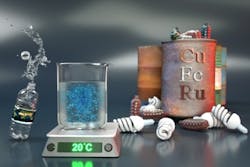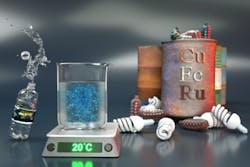Catalyst Revamps Radical Polymerization
Atom transfer radical polymerization (ATRP), a technique now widely used by industry, may gain significant benefits from a metal-free photocatalyst, believe its developers at the University of California, Santa Barbara (UCSB), and the Dow Chemical Co., Midland, Mich. The organic-based catalyst avoids issues of metal contamination that can plague polymers made using traditional metal catalysts and also opens new opportunities in both polymer and small molecule chemistry, they add.
Figure 1. Organic-based photocatalyst obviates metal contamination during controlled radical polymerization. Source: Peter Allen, UCSB.
“The grand challenge in ATRP has been: How can we do this without any metals,” notes Craig Hawker, director of the Dow Materials Institute at UCSB. “We looked toward developing an organic catalyst that is highly reducing in the excited state, and we found it in an easily prepared catalyst, phenothiazine [PTH].”
“Our process doesn’t need heat. You can do this at room temperature with simple LED lights,” he says. “We’ve had success with a range of vinyl monomers, so this polymerization strategy is useful on many levels.”
“It’s a ‘drop-in’ technology for industry," adds Javier Read de Alaniz, the principal investigator on the project and professor of chemistry and biochemistry at UCSB. “People are already used to the same starting materials for ATRP, but now we have the ability to do it without copper.”
PTH provides yields similar to traditional catalysts as well as comparable accurate control of molecular weight, low polydispersity and high retention of chain end groups, the researchers note. This allows sequential preparation of a variety of block polymers, they add. More details on the metal-free ATRP technology appear in a recent article in the Journal of the American Chemical Society.
“One of the most attractive features of this catalyst is its ease of synthesis. We currently make PTH in one step from inexpensive starting materials using a Pd-catalyzed C–N cross-coupling reaction. Additionally, these C–N cross-coupling reactions have already been proven to be effective on large scale and are routinely performed on multi-kilogram quantities,” says Brett Fors, a member of the team who is now at Cornell University, Ithaca, N.Y.
In their work so far, the researchers have observed little to no catalyst degradation. “However, more studies are needed to see if these compounds are robust enough to enable catalyst recycling,” notes Fors.
The researchers now are seeking a better mechanistic understanding of the system. “Understanding the controlling factors in our polymerization will allow us to design more efficient catalysts and extend the scope of these polymerizations to a wide array of monomers,” Fors explains. “We have already started working on this and we already have a handful of new design principles to begin the development of new catalysts.”
The team still faces a number of challenges. “I would say one of the key challenges is making a truly universal catalyst system that enables the synthesis of a wide array of well-defined macromolecular structures,” notes Fors. “Scale-up of photo-mediated reactions offers unique challenges because these processes need uniform irradiation of visible light. We are currently working on developing a continuous manufacturing process in flow that will allow us to scale-up these reactions in an efficient manner,” he adds.
PTH is unusual because it is highly reducing in its excited state. “…We envision that this will enable new reactivity and novel transformations in both polymer and small-molecule chemistry,” says Fors.

